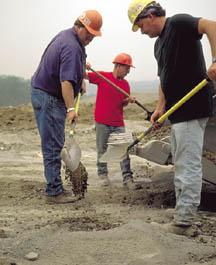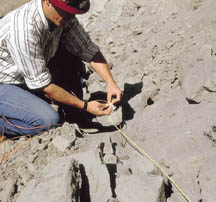What is an Explosives Engineer?
Explosives Engineers, also known as Blasters, are primarily responsible for breaking rock to make way for houses, buildings, roads and bridges as well as extracting minerals, metals, and fuels from the ground to provide power, raw materials, and products for manufacturing and consumer goods.
To become an Explosive Engineer, one must go through extensive training. This includes both on the job training and classroom training. To become an explosive engineer, it is not necessary to obtain a college degree, but there are both undergraduate and graduate programs available for those interested in obtaining advanced degrees in explosives engineering, mining engineering, civil engineering, geotechnical engineering, explosives research or product development.
What Does an Explosives Engineer Do?
Designing the Blast
The most important step for explosives engineers is designing the blast. Explosives Engineers design blasts that will produce desired rock fragmentation results and low vibration levels. They specify explosive quantities and design borehole drill patterns including size, depth, and spacing. These factors vary based on the geology and location of the blast site. Different rock types require different kinds or amounts of explosives and different borehole spacing. Blasts are also designed to produce desired fragmentation, or rock size. In quarries, for example, rock is broken into smaller pieces so it can be easily processed through large crushers and grinders into its final form of gravel or cement.
Knowing how to design blast patterns comes from a combination of training and experience. Tape measures, burden poles, rods and site levels are used to survey the area and pinpoint borehole locations. Each borehole location is marked with spraypaint by the blaster to provide a clear pattern for the driller to follow. The driller then drills each borehole to the blasters' specifications.
Installing Seismographs
Seismographs are strategically placed at structures near the blast site to monitor vibration levels. Blasts are designed to stay within government-recommended vibration levels.
Loading Holes
After the boreholes are all drilled, the blaster returns to the jobsite and loads the holes with explosives. Blastholes are often "topped-off" with stemming material, such as gravel, to help confine the blast.
Pea-sized gravel, called "stemming material" is used to top-off the blastholes. Stemming is intended to confine the energy in the blast.
|

|
Many shots today are connected using non-electric (Nonel) shock tube technology. Non-electric connections are designed to prevent accidental detonation that could be caused by extraneous electrical current sources such as approaching storms, lightning, nearby powerlines, or two-way radio interference. When using electric technology, blasters use a device to check for extraneous electricity prior to connecting the shot.
|

|
Connecting the Shot
After all of the boreholes are loaded with explosives, blasters connect the holes to each other using timing delay mechanisms and then to the main initiation source.
Warning Signal —All Clear
A warning signal is given prior to the blast. This signal tells other workers to leave the area. After the area has been cleared, the blaster makes the final connection to the blasting machine. Another signal is given then, the countdown begins… Ten, Nine, Eight…
Fire in the Hole!
The blaster yells "Fire in the hole!" The shot is fired.
Inspecting the Site
Blasters then inspect the results of the blast to determine if the blast did what it was designed to do. After the blaster has inspected the site and determined that it is safe, he/she gives an all clear signal to indicate to workers that it is safe to return to the site.
Keeping Blast Records
Blasters keep extensive blasting records to help them design future blasts. The records include geology, dimensions, blast pattern sketch, vibration levels, spacing diameter and depth of boreholes, materials used, weather, costs and much more.

